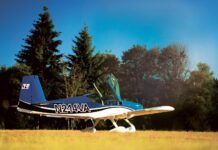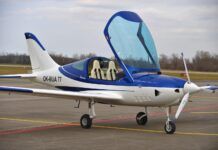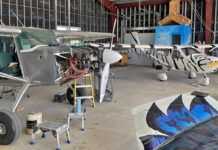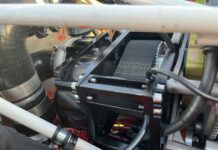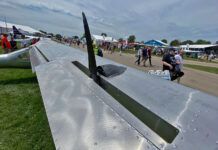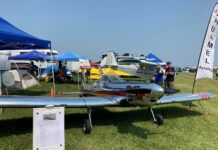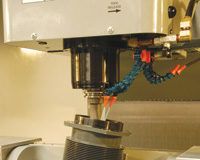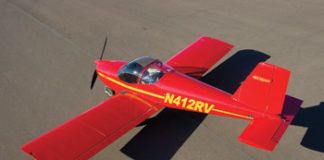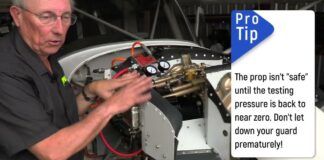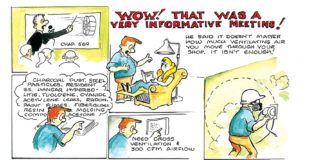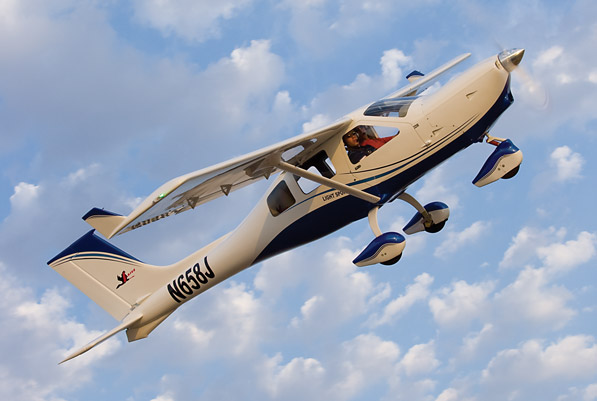
Consider the Jabiru J230 and you might begin to think anomaly. Not as though its a bad thing, like a blotch on your X-ray or the appearance of talking bears at your dinner table. Instead, the Jabiru gains that appellation because its unusual among the popular LSA-legal kit aircraft for being, essentially, a four-seat airplane with only a pair of chairs.
How did it get that way? Jabiru cofounder Rod Stiff decided that it would be possible to expand and guppy out the back fuselage without incurring a significant weight penalty, and if your goal was to fly two parents and two kids, you could refer to the J400-series aircraft as four-placers. Like most designs expanded from two-seat aircraft, though, its more of a 2+2. The J430 and J450 models, licensed as Experimental/Amateur-Builts, have had modest success.
Light Sport Aircraft rules restrict Sport Pilots to aircraft of two or fewer seats, so a simple solution emerged to make the J230 LSA legal: Remove the back seats. Doing so leaves a positively generous baggage bay that might do fine for bedding merchants or inveterate campers, perhaps not so well for anvil salesmen. Shift your focus back to the LSA segment, both as ready-to-fly and Experimental/Amateur-Built examples, and the aircraft capable of carrying as much cargo at reasonable speeds dwindle to but a handful. Norman Explorer, anyone? And after that? Well…we’ll get back to you.
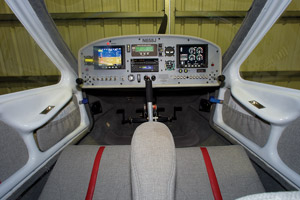
Which Wing for LSA?
Jabiru created a bit of confusion for itself in the J-series nomenclature that were happy to clarify right now. When the LSA rules were set up, Jabirus main candidate was the J200, essentially the same airplane you see on these pages, albeit with a shorter tail boom and a different wing. That wing, with a modest 85 square feet of area, couldn’t get the J200 to meet the 45-knot-clean stall speed requirement.
Jabirus first effort would become the J250, which has a 4416 airfoil of 120 square feet on a 30-foot span with a substantially wider 48-inch chord. Plenty of wing to do the job, but at the LSA-mandated maximum gross weight of 1320 pounds, it provided a kite-like wing loading of 11 pounds per square foot. Naturally, the J250s initial climb and service ceiling were superior to the J200s, but it was slower on the same horsepower and not as nice handling, according to pilots who have flown both the J200 and J250.
Bowing to pressure from the customer base, Jabiru then fitted yet another wing to the J series, one that was designed for a European ultralight aircraft. This is the 31.4-foot-span, 39-inch-chord 4414 wing that would create the J230. At 102 square feet, the J230s wing is sufficiently large to get the clean stall speed to meet the limit of 45 knots (with little to no margin) but provides better cruise performance and acceptable climb rates and service ceiling.
In general terms, the J200 and J400 series aircraft are identical except for the number of seats. The middle digits denote the wing. The current kit offerings are the J230, J250, J430 and J450, plus the J160, the smaller-body Calypso powered by the Jabiru 2200A four-cylinder engine. All others come with the Jabiru 3300 six-cylinder engine of 120 horsepower as the default option. Photos disguise the J230s scale-a pilot of average height will have to duck under the wing getting from the pilots door to the baggage portal.
To meet LSA regulations, both the J230 and J250 have a nominal max-gross weight of 1320 pounds, but if constructed as an amateur-built, either can go up to the J400-series maximum of 1540 pounds. (Just remember that if you build one and register it at 1540 pounds, it can never be reregistered to 1320 so a Sport Pilot can fly it.) Against an empty weight of around 750 pounds, even the LSA model has decent payload. With the 35.5-gallon fuel tanks brimming, you’d have 362 pounds for the cabin. Not a lot, but think about how long you can fly at 6 gph on that amount of fuel. More realistic fuel loads, say 24 gallons for 4 hours total endurance, and you’re on the right side of a 400-pound payload.
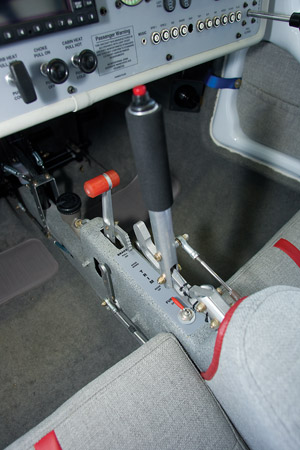
The Turnkey Option
Jabiru is among the few kit manufacturers to offer ready-to-fly examples, which, for the U.S. market, are imported as big pieces from Australia and assembled in Shelbyville, Tennessee. In fact, the airplane flown and photographed for this report is a J230 SLSA (ready to fly) built in the states. Three turnkey models are offered: a big-wing version of the J160 called the J170, as well as the J230 and J250. Factory-built J birds are structurally and systemically the same as the kit iterations, so the homebuilt example benefits from the extensive structural and in-flight testing conducted for the SLSA. This also means that the SLSA we flew is a good stand-in for the Experimental/Amateur-Built you might construct yourself.
We’ll give credit to Shelbyville for the very good fit and finish of the SLSA, a testament to a fair bit of bodywork and attention to detail in the construction. If you have been following Bob Fritz’s builder series on his J230, you know that the raw materials range from elegantly neat to Oh boy…look at that! Fritz also reported that incremental changes in the design weren’t always reflected in the documentation, but as his project progressed, this disparity began to narrow. In plain words, the factory is starting to catch onto the documentation shortcomings and is doing something about it.
If parts of the kit are rough around the edges, it’s likely to be a reflection of Outback flying thats a part of the Jabirus gestation. Although strictly a trigear, the J230 was built with the intention of operating from unimproved strips. Fiberglass maingear legs are forgiving of uneven terrain, and you wont find shopping-cart wheels under the composite wheelpants—though, to be fair, they’re not 31-inch bushwheels, either. The steerable nosewheel has an integrated shock/spring mechanism, and with the two-blade ground-adjustable prop fitted, there’s plenty of ground clearance.
Because the Aussies tend to fly from few long, paved strips, the original brakes weren’t required to do much besides keep the airplane from creeping during runup. And thats why even the U.S. western importer, Jim McCormick, strongly recommends upgraded Matco brakes. They were on the demonstrator aircraft we flew and worked great.
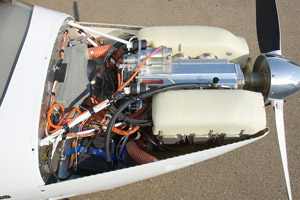
Captain Quirk
Jabiru’s Rod Stiff has a clear mind and modest temperament, but his own way of doing things. For example, the earliest Jabirus had throttle controls on the cabin floor between the legs. Such a setup made sense for the dual throttle controls to manage the single Bing constant-velocity carburetor on the 3300, but it was like asking pilots to copy an ATC clearance and chew gum at the same time. Later kits and this SLSA have conventional push-pull throttles in the instrument panel, outboard near the doors. Because the rudder pedals act directly on the nosewheel for steering-a bit like a Piper Cherokee-there’s a single brake lever, positioned just ahead of the control stick.
In between the seats is a tall stick that rotates left and right on a vaguely J-shaped apparatus that also supports the pivot for the pitch function. The rod attached to the stick below the foam grip is your first clue about Teleflex cables. Huh? Instead of conventional pull cables or torque tubes and pushrods, the Jabiru uses Teleflex push-pull cables for pitch, roll and yaw. The single pitch-control cable arrives up under the center console and attaches to the stick a few inches above the pivot; aileron control cables (one for each wing) attach behind the seats and travel upward in an arc to the wingroots.
Teleflex cables have some distinct advantages, primary among them simplicity and easy rigging of the controls. On the other side of the ledger: They represent a single-point failure (but then so does a single elevator pushrod, for example) and have inherent friction. Despite employing spring centering packs, the controls lack definition. Move them a bit from their resting place and they tend to stay there. Resistance to movement is discernible on the ground, and you wonder what it will do to the flying qualities.
So Let’s Talk Flying Qualities
Down to its stout little fiberglass core, the Jabiru is a straightforward design. Effort was clearly made to keep the systems basic and operation as uncomplicated as possible. Starting the 3300 is a matter of turning the key with the throttle shut, or pulling on a bit of choke if the engine is cold. It whirs to life in a blade or two and settles into a smooth, quiet idle. Bring the rest of the systems on line, allow the Grand Rapids EFIS to boot up, and within a minute or two you’re ready to taxi.
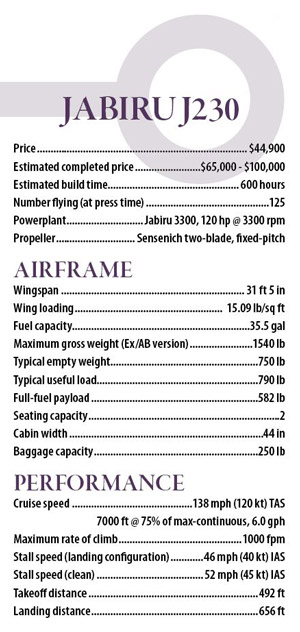
Here’s where the J230 is unusual, though thats not to say bad. The direct nosewheel steering requires a moderate amount of force to make 90 turns, but the pedals have a fairly short throw. So unlike flying, say, a Cessna 172, where the pedal movements are large and the responses slow, the Jabiru is quick to change direction. The other quirk comes with braking, committed with a lever ahead of the center stick. Although I am accustomed to right-hand-throttle and braking with the feet, taxiing with left-hand throttle and right-hand brake wasn’t much of a challenge.
Runup complete-meaning that you’ve confirmed trim and flap positions and checked the ignition system as the killer items-you’re ready to trundle onto the runway. Recommended procedure is to hit full throttle and steer with the nosewheel until you lighten the nose at 45 knots indicated (KIAS). Like a Cherokee, the Jabiru requires less pedal displacement to track the centerline than it will need to keep the nose aligned after you hoist the third wheel. Be ready to give it more right rudder just at rotation, and center the rudder if the nosewheel should head back down.
The Jabiru accelerates smartly and is soon up to 70 KIAS, at which time you can retract the flaps. At 2760 rpm (max is 3300), the J230 climbed out on a warmer-than-standard day (from near sea level) at 80 knots and 650 fpm. At the best-rate-of-climb speed of 85 KIAS, climb rate improved to between 700 and 800 fpm-this with approximately 18 gallons of fuel on board and 350 pounds of pilots up front. Visibility over the nose is good, though the taller panel fitted to N658J impedes vision somewhat; the standard kit-version panel is slightly smaller and lower than the SLSAs. Builders can, of course, fit either panel, and it’s probably worth the slight reduction in forward visibility to have the room for avionics.
At these lower speeds, the Jabiru flies conventionally. The control friction you noticed on the walkaround isn’t much of a factor, though its discernible in flight if you’re really paying attention. More evident is the difference in roll response between the short-wing J200 and this long-wing J230. The J200 is slightly crisper, though its a stretch to call the J230 anything but pleasant as long as you don’t mind giving the stick a fair amount of initial displacement to get the roll rate going. Then you take it out to set the roll angle. Neither airplane, the J200 or the J230, is RV-8 quick in roll; more like a lightweight Cessna 172, and thats not meant as an insult.
Plausible Performance
An airplane with so much cargo capacity can be excused for not possessing blazing speed, but the Jabiru acquits itself well. The Grand Rapids EFIS calculated 118 knots TAS at 6000 feet density altitude and 2850 rpm; though we didn’t have a fuel-flow gauge, the book calls for around 6 gph at that power setting. A two-way speed run upwind and down validated the calculation. At this speed, the controls firm up a bit, but remain well-balanced, and if that tach reading suggests a high-strung little screamer, you haven’t flown behind a 3300. Its amazingly smooth at this speed, and seems, if anything, under-stressed.
Slow flight is the real eye opener. Once you’re accustomed to crossing your left arm over your body to reach the lower left edge of the center console where the trim lever resides, changing speeds proves easy. With flaps up and the J230 slowed to 60 KIAS, the nose is definitely high on the horizon and the stick is unmistakably far back, though the rudder and (to a lesser extent) the ailerons remain effective. As you slow by reducing power, you’ll eventually get to 55 KIAS with the stick full back, where you’ll find a mild burble and no tendency to roll off. Its hard to describe it as a break; its more like a stall-mush. During our entire flight, the Jabiru 3300s temperatures remained comfortably in the green.
Add flaps for slow-flight and stall demonstrations. The major difference is that the nose is more level to the horizon with the stick full back, and the airplane is slower to accelerate on recovery. At 42 KIAS and idle power, the airplane wants to sink at 500 fpm but shows no inclination to actually break. One of the key indicators is that you’ve had to lift your right elbow off the cushion to make room for the long stick held in the full-nose-up position.
The Jabiru’s no-nonsense approach continues into the landing phase. Recommended speeds are 75 to 80 KIAS on the downwind, slowing to 65 to 70 KIAS on final, flaps and weight being the determining factors. Another difference between the J200 and J230 emerges on the roundout. With the larger wing and effective flaps, the J230 wants to float if the final-approach speed isn’t right on the money. And once you get it through your head to take out rudder displacement as the nosewheel descends to the runway, smooth, consistent landings are yours.
Building, Then Flying
In every flight regime sampled, the J230 performed admirably, and leaves the impression of a good-natured, docile and easy-to-understand aircraft. To that, lets throw in reasonable costs-the fastbuild kit (the only way it comes) is $44,900 less engine, interior, instruments and paint. The Jabiru 3300 engine runs $17,500, which seems quite the good deal with the Rotax 912 on the other side of $20,000 these days. Constructed as an Experimental/Amateur-Built, the J230 could be the ideal design for pilots who want a tidy, efficient package capable of hauling a load. The more time you spend with the J230, the less its layout seems like an anomaly and the more it appears simply to be a great idea.
For more information visit jabiru.net.au.



